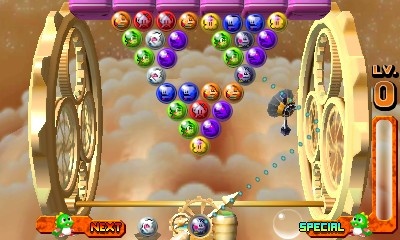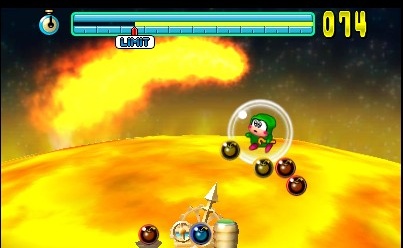You've probably played Bust-A-Move (aka Puzzle Bobble) before. This bubble-bursting puzzle series has been around since the mid '90s, and its uncomplicated formula has, at times, evolved to include different-shaped levels, tournament-style play, and even level creation tools. Bust-A-Move Universe offers none of these. Unlike plenty of its predecessors, this simplistic 3DS game doesn't even support two players. All you get for your $30 is a Puzzle mode that can be beaten in under three hours and a Challenge mode that, depending on which variation you opt for, lasts for either a maximum of five minutes or for so long that your handheld's battery life is likely to become a factor. It has been a decade or so since the arrival of a new Bust-A-Move game was something to get excited about, and that hasn't changed with the release of Universe.

As in the original 1994 arcade game, your goal in Bust-A-Move Universe is to clear the screen of colored bubbles, which generally form a wall of sorts at the top of the screen. You do this by shooting your own bubbles from the bottom of the screen and attempting to group three or more bubbles of the same color together so that they burst. A few unimaginative power-ups occasionally come into play (though you won't need any of them to get through the Puzzle mode), and the fact that bubbles periodically get pushed down the screen toward you adds some sense of urgency, but that's just about all there is to it.
What little meat there is on Bust-A-Move Universe's bones comes courtesy of the Puzzle mode, which spans some eight different planets, each composed of 10 levels and one laughable boss fight. The most interesting feature of Puzzle mode is that there are a number of keys to collect on each planet, and the only way to collect them is to burst adjacent bubbles. Sounds easy enough, and it is, but you have to be precise with your aiming to keep the key suspended from above before you collect it, otherwise the key falls out of view and is lost. Collecting keys adds some much-needed challenge to the Puzzle mode cakewalk, but ironically it also takes away any challenge from the boss battles at the end of each planet. That's because the imprisoned dragons that you rescue with the keys reward you with a rapid fire ability for your encounters with their respective captors. Given that these battles invariably involve just shooting bombs at the bubbles that the bosses are floating around the screen in, the rapid fire ability might as well be an "I win" button. It's true that you need to match bombs of the same color in order to hurt the bosses, and that you have more colors to contend with toward the end of the game, but if you've freed the dragon, its captor will rarely give you any problems. And in the unlikely event that you fail to defeat a boss, you still complete the mission and are able to move on to the next planet.
You're free to revisit any Puzzle mode planets that you didn't complete 100 percent if you want to improve upon your scores, but there's little incentive to do so. There's no way to share your scores with other players, and you don't even get to enter your name or initials alongside your scores on the leaderboards. Furthermore, Bust-A-Move Universe supports only one save file, so if you share the game with a friend, there's no way to keep your scores or progress separate. Sadly, these shortcomings also impact the misleadingly titled Challenge mode.

One of the best things that can be said about Challenge mode is that, unlike Puzzle mode, it offers three difficulty settings. In Puzzle mode you always have a guideline showing you exactly where your bubbles are going to land, and you can take as long as you want to launch them. In Challenge mode, you have the option to impose a time limit on each of your shots and also to turn off the guideline. You can also choose to play for 100 seconds, five minutes, or with no time restriction whatsoever. The short games are harmless enough, but the "nonstop" option should be selected only if you have plenty of time on your hands. The difficulty curve ramps up so slowly that you could conceivably be playing for well over an hour before the wall of bubbles even threatens to reach the bottom of the screen and end your game. That's not only because they move down so slowly and often appear in patterns that are easy to clear, but also because special "gimmick bubbles" have a habit of working their magic anytime you catch a glimpse of the "Game Over" light at the end of the tunnel. Bomb bubbles burst all other bubbles in a wide radius; rescue bubbles push the wall back up the screen; and rainbow bubbles create rainbows on the screen that destroy a row of eight bubbles and then, like those in the Rainbow Islands games, fall to the bottom, destroying anything that gets in their way. In short Challenge games the gimmicks are a welcome sight, but when playing nonstop you might end up cursing their very existence.
Like its gameplay, Bust-A-Move Universe's presentation lacks ambition. Some subtle but pleasing 3D effects and some rotating planet graphics aside, this looks and sounds much the same as Bust-A-Move games always have. Take away the 3D visuals, and the latest entry in this long-running series would be almost indistinguishable from many of its predecessors save for the fact that it comes with a bigger price tag and has less to offer.